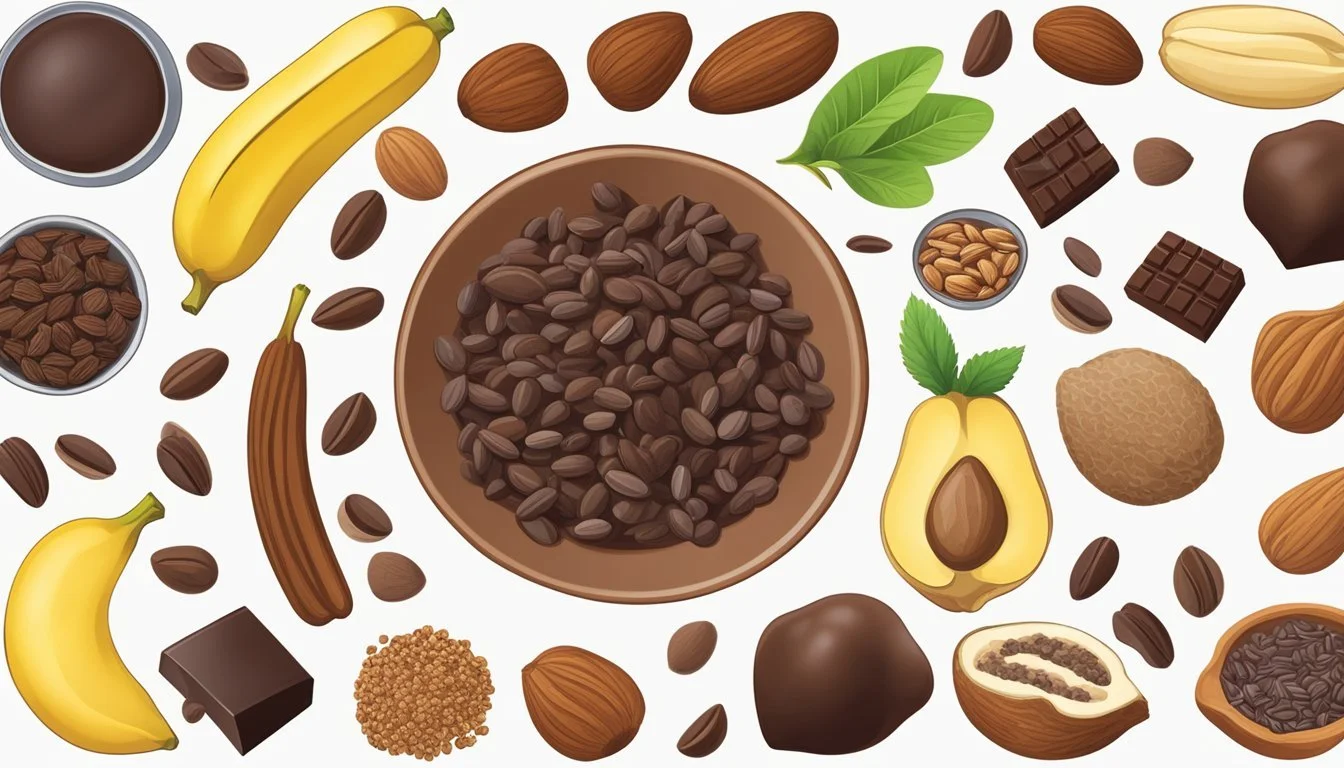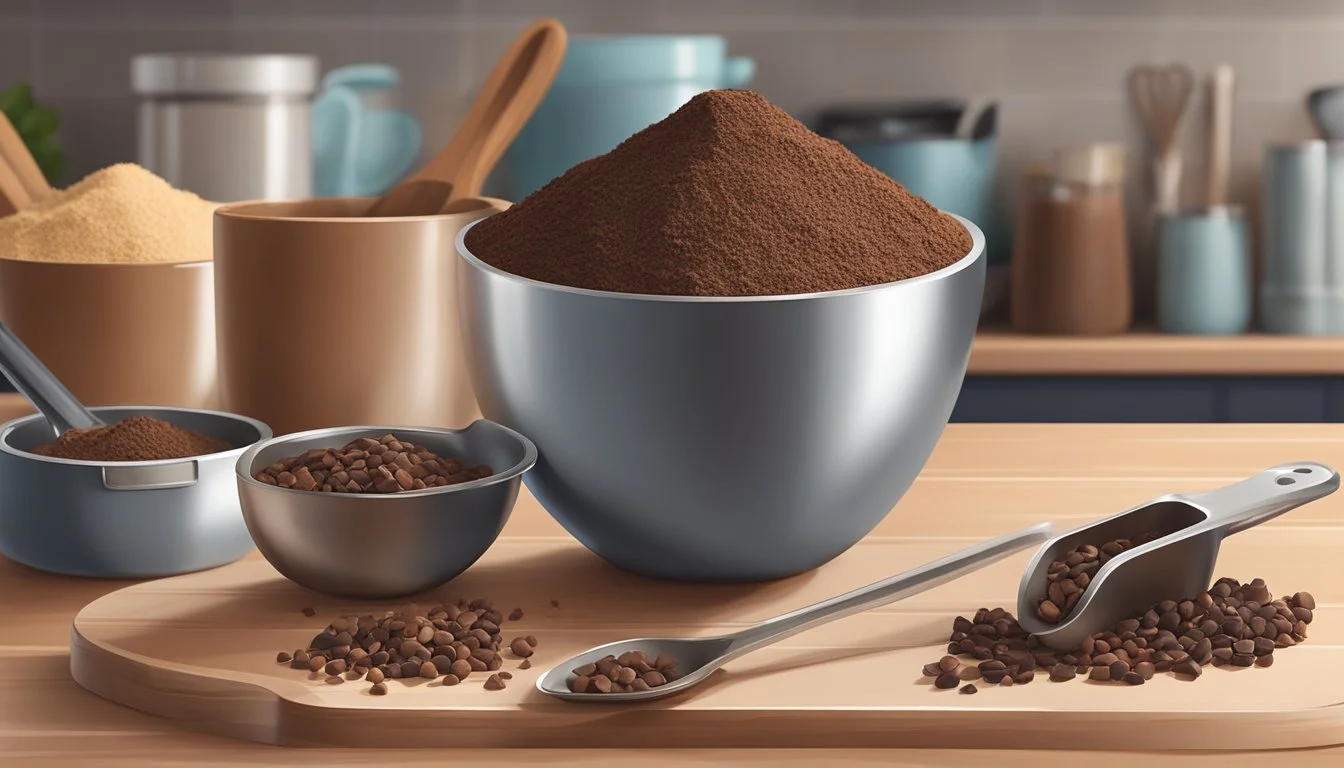Chocolate Substitutes
A Guide to Alternative Cocoa Ingredients
Chocolate (What wine goes well with chocolate?), with its rich flavor and velvety texture, is a beloved ingredient in a plethora of sweet and savory recipes. However, for a variety of reasons ranging from health constraints to dietary choices, one might seek alternatives to traditional chocolate. Chocolate substitutes can be designed to mimic the taste and texture of the original to varying degrees, allowing them to be swapped into recipes with relative ease.
Several substitutes come close to offering the complex taste profile of chocolate. Carob powder is one such alternative that can provide a similar flavor with additional health benefits such as being caffeine-free and lower in fat and sugar. Bakers often lean on unsweetened cocoa powder, which, when combined with the right proportions of fats like butter or oils, can replace unsweetened chocolate in recipes without compromising the desired chocolatey essence.
When incorporating chocolate substitutes into recipes, it’s essential to consider the specific type of chocolate requirement—be it semisweet, bittersweet, or cocoa powder—as each has distinct characteristics in flavor and chemical properties that affect the outcome. Substitutes are not only about matching flavor but also about achieving the desired end-product texture, for which adjustments to accompanying ingredients like baking powder may be necessary to replicate the leavening effect that some forms of chocolate provide.
Understanding Chocolate Substitutes
When seeking alternatives to traditional chocolate, understanding the variety of substitutes and their uses is crucial. This knowledge allows for informed choices that cater to dietary restrictions, health considerations, and taste preferences.
What is a Chocolate Substitute?
A chocolate substitute refers to any product used in place of regular chocolate due to health, ethical reasons, or availability. These substitutes mimic the taste, texture, or function of chocolate and can vary extensively in their composition. Some substitutes may still contain cocoa derivatives, such as cocoa butter, while others completely eliminate all components originating from the cacao plant.
Common substitutes include:
Cocoa Powder + Vegetable Oil (for unsweetened chocolate)
Carob Powder
Almond Butter mixed with Cocoa
Reasons for Using Substitutes
Individuals turn to chocolate substitutes for several reasons. For those with a cocoa allergy, avoiding chocolate is necessary to prevent allergic reactions. Chocolate substitutes offer a safe alternative for these individuals to enjoy similar flavors without health risks.
Lactose intolerance is another motivator for using substitutes; milk-free options are widely available to cater to this dietary limitation.
People following a vegan diet often seek substitutes that do not contain any animal-derived ingredients, typically found in many traditional chocolates.
Here’s a quick breakdown of substitute uses:
Reason for Substitution Substitute Examples Cocoa Allergy Carob Powder Lactose Intolerance Dark Chocolate with no milk content Vegan Diet Cocoa Powder + Vegetable Oil blends
This section covers the essence of what a chocolate substitute is and why people may choose or need to use them.
Types of Chocolate Substitutes
When looking for chocolate alternatives, one must consider the specific type they need to replace, be it for dietary restrictions, health considerations, or lack of available ingredients. Various substitutes can closely mimic the flavor and texture of traditional chocolate products.
Cocoa Powder Alternatives
Cocoa powder is a common ingredient in many chocolate recipes. An effective substitute for cocoa powder is Dutch-process cocoa powder, which has been alkalized to reduce acidity. It's important to adjust leavening agents accordingly—the general rule is to use twice as much baking powder in place of baking soda when using Dutch-process cocoa powder.
For 1 ounce cocoa powder:
Use 1 ounce Dutch-process cocoa powder.
If using baking soda, replace with twice the amount of baking powder.
Carob-Based Substitutes
Carob powder, derived from the pods of the carob tree, offers a chocolate-like flavor without caffeine or theobromine, making it a favorite for those with dietary constraints.
Chocolate Chip Replacement:
Cocoa butter can replace chocolate chips, providing a creamy texture and rich flavor, particularly suitable for cookies and cakes.
Health Consideration:
Carob is naturally sweet and high in fiber, making it a health-conscious substitute.
Other Substitutes
Sometimes one needs a more direct replacement for certain types of chocolate:
Unsweetened Chocolate: Composed of pure cacao butter and solids, it lends a bitter flavor ideal for baking but not suited to eat alone.
Dark Chocolate as a substitute should contain a minimum of 35% cacao and less sugar than milk or white chocolate.
Milk Chocolate: Generally requires a combination of chocolate liquor, milk ingredients, sugar, and cocoa butter. It features at least 35% cocoa solids.
Substitute Options: Equal amounts of sweet or semi-sweet chocolate.
White Chocolate: Lacks cocoa solids but includes cocoa butter, sugar, and milk solids.
Substitute Table for Recipes:
Original Chocolate Substitute Milk Chocolate Equal amounts of sweet or semi-sweet chocolate Dark Chocolate High cacao content, minimal sugar White Chocolate Use cocoa butter-based products Unsweetened Baking Chocolate Unsweetened chocolate or high-cacao dark chocolate
Each substitute offers a slightly different flavor profile and baking characteristics, so it's wise to choose one that aligns closely with the desired outcome of the recipe.
Using Substitutes in Recipes
When substituting chocolate in recipes, it's crucial to consider sweetness, fat content, and texture to maintain the integrity of the final product.
Adjusting Sweetness
In chocolate recipes, sugar plays a vital role in achieving the desired sweetness. When using a substitute such as cocoa powder in place of unsweetened baking chocolate, one must account for the lack of sugar. For 1 ounce of unsweetened chocolate, a common substitution is 3 tablespoons of cocoa powder plus 1 tablespoon of granulated sugar to match the original sweetness.
Managing Fat Content
Fat content greatly affects the mouthfeel and richness of chocolate treats. Substitutions for high-fat ingredients like chocolate chips or baking chocolate should consider the fat source. For instance, when substituting for 1 ounce of unsweetened chocolate, adding 1 tablespoon of butter or vegetable oil to 3 tablespoons of cocoa powder can replicate the smooth fat content typically found in chocolate bars.
Altering Texture
The texture of baked goods like cookies and brownies is partly determined by the chocolate used. Unsweetened chocolate provides structure and can be replaced with a combination of cocoa powder and a fat such as butter to maintain a comparable texture. However, for candy bars and similar confections that rely on the firmness of chocolate, substituting with cocoa powder may not achieve the desired outcome.
Health and Dietary Considerations
When selecting a chocolate substitute, consumers must consider how these alternatives align with nutritional needs and dietary restrictions, focusing on factors like fat content, the presence of cacao, and suitability for certain diets.
Analyzing Nutritional Profiles
Chocolate substitutes vary in their nutritional content, so it's essential to compare their profiles to understand their health implications. For instance, carob, a common alternative, manifests no stimulants such as caffeine or theobromine, compounds abundant in cacao, making it a more suitable option for those sensitive to stimulants. Carob is also lower in fat than chocolate derived from the cacao bean.
Examining another popular substitute, almond butter, one finds a different nutritional angle. Almond butter is high in monounsaturated fats, which are considered heart-healthy. It also provides a good amount of antioxidants, which can mitigate oxidative stress in the body, though the levels can differ from those in high-cacao chocolate products.
Addressing Dietary Restrictions
For individuals with specific diet-based criteria, like a vegan diet, plant-based substitutes devoid of animal products such as dairy present an important consideration. Chocolate often contains milk, which is unsuitable for vegans and people with lactose intolerance. Substitutes like dark chocolate with a high percentage of cacao solids or dairy-free milk chocolates often employ alternative milks made from nuts or soy.
Those with a cocoa allergy must avoid all forms of cacao and may find solace in chocolate alternatives like carob, which does not contain any part of the cacao bean. Additionally, for individuals who must monitor their sugar intake, many chocolate substitutes offer reduced or no sugar options, utilizing sweeteners that provide a chocolate-like experience without the high sugar content.
Baking and Cooking Techniques
When using chocolate substitutes in baking and cooking, understanding the right ratios, methods, and temperature adjustments is crucial for success.
Substitute Ratios
For Cocoa Powder: To substitute for baking chocolate, use an equal amount of cocoa powder mixed with a fat such as butter or oil. For example, 1 ounce of baking chocolate can be replaced with 3 tablespoons of cocoa powder plus 1 tablespoon of butter or oil.
For Carob Powder: As a chocolate alternative, use 3 tablespoons of carob powder to replace 1 ounce of cocoa powder. There is no need to adjust the existing amounts of baking soda or baking powder if both are present in the recipe.
For Chocolate Chips: When a recipe calls for chocolate chips, an equal amount of carob chips or white chocolate chips can be used.
Melting and Mixing Methods
One must carefully melt chocolate substitutes to avoid altering their texture. Carob powder, which is often used as a chocolate substitute, doesn’t melt the same way and therefore should be combined with dry ingredients. When mixing cocoa powder with fat to mimic melted chocolate, melt the fat first, allow it to cool slightly, then whisk in the cocoa powder until smooth.
Baking Times and Temperatures
Adjustments to baking time and temperature may not be needed when substituting different forms of chocolate in a recipe. However, bakers should be vigilant as the moisture content in substitutes can vary from that of regular chocolate. For example, when baking chocolate chip cookies, the oven temperature can generally stay the same, but the baking time might be less if using drier substitutes. Cake and brownie recipes typically fare well with substitutes without any alteration to baking time or temperature. The key is to perform the toothpick test—a toothpick inserted into the center should come out clean or with a few moist crumbs attached, indicating doneness.
Shopping for Chocolate Substitutes
When selecting chocolate substitutes, consumers should prioritize finding high-quality alternatives that replicate the flavor and function of traditional chocolate, while also understanding the best practices for storage to maintain the integrity of these substitutes.
Identifying Quality Substitutes
Shoppers must look for substitutes that can effectively mimic the characteristics of chocolate. For baking, one may consider cocoa powder as a direct replacement, with Dutch-process cocoa powder being an alternative option due to its smoother flavor profile. Carob powder constitutes a caffeine-free choice, with a naturally sweet flavor, which is ideal for those with dietary restrictions. In savory applications or for textural similarity, almond butter with cocoa can offer a creamy consistency and rich taste.
For treats like chocolate chips, where the shape and melting properties are important, one can explore alternatives like dark chocolate chips that contain at least 35% cocoa solids. These provide a similar mouthfeel and richness as milk chocolate but with a more profound chocolate flavor.
Storage and Shelf Life
A common factor affecting the shelf life of a chocolate substitute is the presence of dairy. Substitutes like milk chocolate should be stored in a cool, dry place, ensuring a shelf life of approximately one year. For dark chocolate substitutes, which often contain less dairy, consumers can expect a slightly extended shelf life due to the higher percentage of cocoa solids that act as a preservative.
Substitute Pantry Shelf Life Best Storage Practice Cocoa Powder 2 years Sealed container, cool, dark place Dutch-process Cocoa 2 years Sealed container, cool, dark place Carob Powder 1 year Sealed container, cool, dark place Almond Butter 2-3 months Refrigerate after opening Dark Chocolate Chips 2 years Sealed container, away from heat
For pantry storage, one should note that factors such as temperature fluctuations and humidity can impact the quality and shelf life of the chocolate substitute. In all cases, the original packaging or an airtight container is recommended to prevent the absorption of odors and moisture.
Culinary Applications Beyond Baking
Chocolate substitutes find their place not just in baked goods, but across a spectrum of culinary applications. They are instrumental in creating non-baked desserts, adding depth to savory dishes, and enhancing beverages with their rich flavors.
Desserts and Confections
Substitutes for chocolate, such as carob or Dutch-process cocoa powder, serve well in desserts and confections that don't require baking. For instance, they can be used to make puddings, tarts, and pies where chocolate's presence is essential. They can also play a significant role in creating ganache for truffles without resorting to traditional chocolate bars. In making s'mores, almond butter mixed with cocoa powder can offer a distinct yet satisfying chocolate-like flavor without using milk chocolate.
Pudding: Use 3 tablespoons of carob powder in place of each ounce of cocoa powder.
Ganache: Melt equal parts of a chocolate substitute with heavy cream to achieve the desired consistency.
Savory Dishes
In savory applications, a chef might incorporate cocoa powder or a rich dark chocolate to craft complex sauces, or give a unique twist to chili and mole dishes. The subtle bitterness of cocoa can balance flavors in meat rubs and marinades, imparting depth without overpowering the primary ingredients.
Marinades: Add a teaspoon of cocoa powder to help develop a rich crust on meats.
Chocolate-infused sauces: Melt a small piece of dark chocolate into the sauce for a silky and luxurious finish.
Beverages
When it comes to beverages, chocolate substitutes can create drinks that cater to varied dietary needs and tastes. For a dairy-free chocolate milk, one could blend cocoa powder with almond milk and sweetener. For those looking for a twist on traditional chocolate desserts in a drinkable form, a mock chocolate frappe using carob powder offers a caffeine-free alternative.
Chocolate Milk: Combine almond milk with cocoa powder and your choice of sweetener to taste.
Chocolate Dessert Beverages: Blend frozen banana with carob powder, a teaspoon of vanilla extract, and almond milk for a healthy frappe option.
Regulatory and Labeling Information
Regulatory guidelines dictate that accurate labeling is essential for chocolate products, ensuring consumers have reliable information for their dietary decisions. This compliance is safeguarded by federal administrations, primarily the FDA, which sets standards for ingredients such as cocoa butter and chocolate liquor.
FDA Standards
Under FDA regulations, chocolate products must meet specific composition requirements to be labeled as chocolate. For instance:
Cacao Bean: The primary ingredient in chocolate, which upon processing, yields various products including chocolate liquor and cacao nibs.
Chocolate Liquor: This is the pure, liquid form of chocolate extracted directly from the cacao bean, and it must be present in certain percentages, depending on the type of chocolate.
Cocoa Butter: A vital component of chocolate derived from the cacao bean, which contributes to the chocolate's melt and texture.
Emulsifiers and Stabilizers: Ingredients such as lecithin may be added to chocolate to enhance its texture and shelf life. These additives must be explicitly stated on the label.
Manufacturers must comply with Title 21, Part 163 of the Code of Federal Regulations (CFR) concerning cocoa products. Non-compliance can lead to penalties, underlining the importance of accurate ingredient listing and product description.
Understanding Labels
Consumers who understand labels can make informed decisions when selecting chocolate. A chocolate label must clearly display:
Ingredients: A complete list, including cocoa butter, emulsifiers, and any other additives.
Origin: Source of the cacao beans, if the product claims a single origin.
Cacao Percentage: Amount of cacao content, including both chocolate liquor and added cocoa butter.
Furthermore, for consumers with dietary restrictions, labels must indicate the presence of common allergens. Accurate labeling ensures consumers are aware of what they are consuming, giving them control over their nutritional choices.






